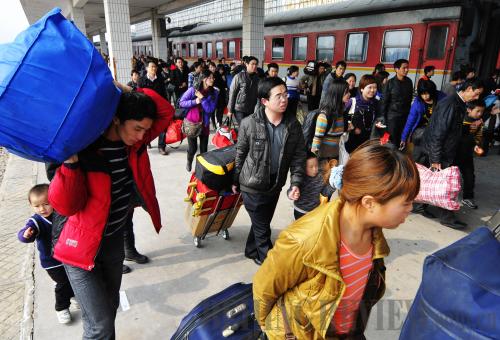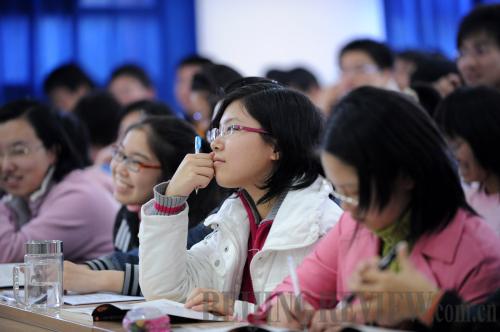|
 |
|
TRANSPORTATION PRESSURE: Passengers walk out of a railway station in Quanzhou, Fujian Province, during this year's Spring Festival. The eastern coastal province reported a passenger transportation volume of 44 million people in the weeklong holiday (WEI PEIQUAN) |
The sixth national population census also reveals the provincial population chart was reshuffled in the 2000-10 period as the top five most-populous provinces were Guangdong, Shandong, Henan, Sichuan and Jiangsu, while the ranking in 2000 was Henan, Shandong, Guangdong, Sichuan and Jiangsu.
"We can see that the Pearl River Delta, the Yangtze River Delta and the Beijing-Tianjin belt are getting denser, which means the uneven population distribution has been worsening instead of getting eased," said Zhai.
The overly dense population in coastal areas including Guangdong has posed great challenges to many aspects of the urban life: resources, the environment, housing, transportation and the cost of labor.
"Many of the large cities resort to hukou, or registered permanent residence, to curb the swelling population but it always ends up in vein," said Li.
"It is warning us that our social and economic policies concerning population distribution should be apt to guide the population flow to a reasonable direction, such as cities in the central region and the Bohai Rim," said Zhai.
Low fertility
According to the sixth national population census, China's fertility rate now was less than 1.5 children per couple in 2000-10. It is on par with, or lower than, those of developed countries such as the United States, France and Spain.
"The rate is alarmingly low for a large country like China," said Wang Feng, a population expert and Director of the Brookings-Tsinghua Center for Public Policy in Beijing.
In the same period, China added about 40 million people aged 60 years and older. The number of senior citizens grew because of the longer life expectancy. The proportion of senior citizens to the population has also risen due to the low birth rate.
Wang said the census results should be a wake-up call to policymakers to stop pushing the gas pedal on an existing downward trend.
 |
|
WELL EDUCATED: Students attend class at the University of Science and Technology of China in Anhui Province. The sixth national population census showed Chinese citizens' education level improved remarkably in the 2000-10 period (CHEN YEHUA) |
In the early 1970s, the Chinese Government became increasingly aware that the overly rapid growth of the population was unfavorable to economic and social development. It decided to vigorously carry out family planning in both urban and rural areas and integrated the plan for population development into the plan of national economic and social development.
At the end of the 1970s, the Chinese Government made it a basic state policy to carry out family planning and population control and to improve the living standards of the population, and has clearly incorporated it in the Constitution.
According to Mu of Peking University, the family planning policy compromises the long-term demographic balance to ease short-term population pressure, but in the process, triggers other population-related problems, including heavier pension burdens, a worsening gender imbalance and labor shortages.
| 